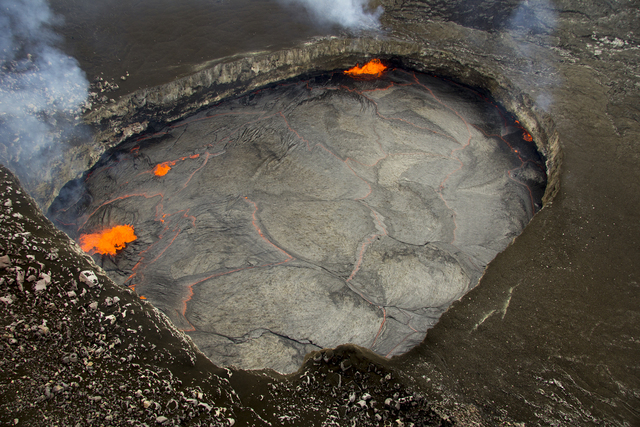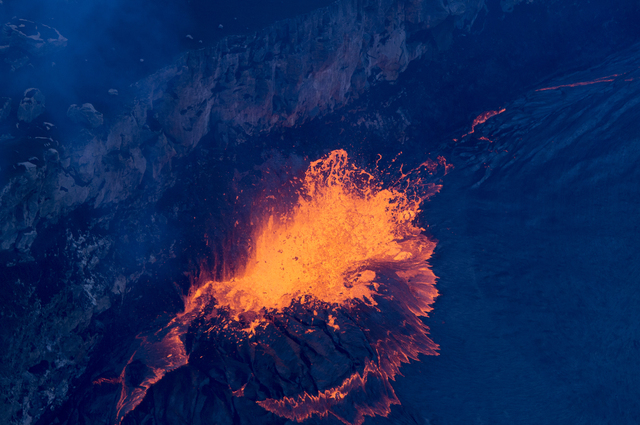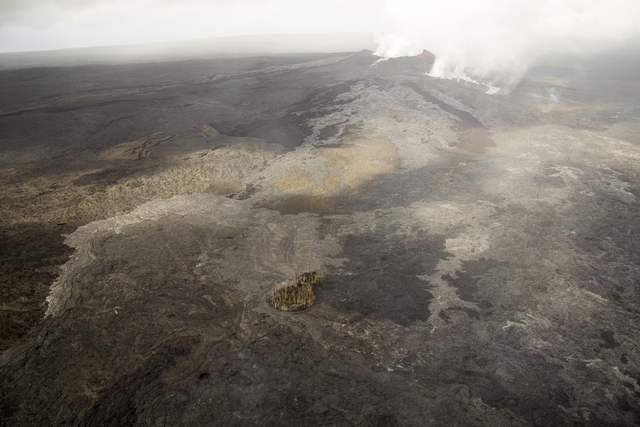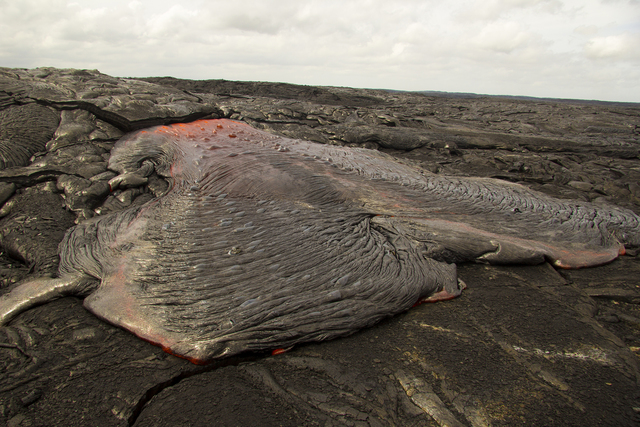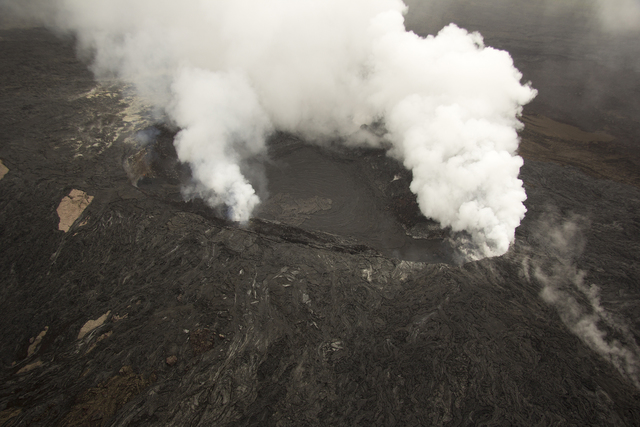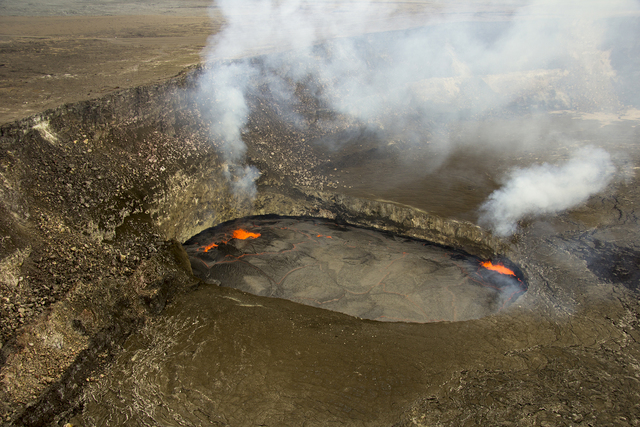Kilauea Summit lava lake at highest level since 2008
The lava lake within Kilauea Volcano’s summit Overlook Crater on Thursday reached its highest level since the crater opened in 2008, a scientist with the U.S. Geological Survey Hawaiian Volcano Observatory tells West Hawaii Today.
As of 12:40 p.m. Thursday, lava had filled the crater to within 68 feet (21 meters) of its rim, which is located within Halemaumau Crater at the volcano’s summit, said Janet Babb, a geologist with the observatory. The Overlook Crater is located about 279 feet below Halemaumau’s rim. Jaggar Museum sits about 0.8 mile from the edge of Halemaumau Crater.
Thursday evening, scientists said the lake had risen another two feet.
Such fluctuation is normal at Kilauea’s summit lava lake, however, the fact that it rose to such a level is notable, Babb said. About 7 a.m. Thursday, scientists had estimated the lava was about 90 feet below the rim and on Wednesday, the lake hovered between 100 and 130 feet below the rim.
“The summit lake level fluctuates all the time, this is just a little bit unusual as to how high it came up,” she explained. “There have been times when (the lake) has dropped below view and times when it has been higher.”
Though within 70 feet of the rim on Thursday, much of the actual lava activity remained out of the view of visitors to Jaggar Museum at Hawaii Volcanoes National Park, Babb said. Some spattering was visible on webcams for a short period Thursday morning and diminished winds Thursday morning made it possible to hear the lava bubbling within the vent. Steam rising from the vent was also visible in webcams.
“That’s the exciting part,” Babb said. “People still can’t see the actual lava lake from the Jaggar overlook but because the tradewinds have calmed down, when I pulled into the parking lot this morning I could hear the lava.”
Steve Brantley, deputy scientist-in-charge at Hawaiian Volcano Observatory, estimated a portion of the lake could be visible from the museum if it climbs another 10 feet.
“If it keeps rising at the same rate maybe within a day one part of the lava lake might be visible but not the whole thing,” he said Thursday.
“You might be able to see one corner of it.”
The current rise in the lava lake level comes amid a period of steady inflation at the summit, which began abruptly Tuesday afternoon and continued through about 2:30 p.m. Wednesday, Babb said. The rate further increased Wednesday evening into Thursday.
During inflation, magma rises into the summit reservoir, according to the observatory. The summit reservoir enters the deflation portion of the cycle when the magma moves laterally into a rift zone and either erupts or is stored there.
Babb said scientists are monitoring the situation to determine if the activity at Overlook Crater has any impact on the East Rift Zone eruption. However, past observations and experience indicate there is a connection between the summit activity and activity at the other areas.
“There is a definite connection in that the magma reservoirs within Kilauea feed both the summit eruption and the East Rift Zone eruption,” she said. “We have seen a connection and sometimes the inflation-deflation will have an effect — usually a delayed effect — on the East Rift Zone.
“If the summit inflates that indicates that less magma is coming into that reservoir or more lava is being fed out of the East Rift Zone. It’s a hydrostatic connection: If you have a single source feeding two vents, one is taking more from the other,” she said, cautioning that the correlation is not always one-to-one.
The lava lake previously reached a high in October 2012 when it rose to within 77 feet of the Overlook Crater rim, Babb said. In March 2011, the lava lake level was so low it was “essentially out of view.” The activity also came amid a period of inflation that later entered the deflation phase without notable incident.
“It’s part of the activity here that we get these inflation-deflation events,” she said, “so, this is all part of the ongoing activity at Kilauea.”
The Overlook Crater within Halemaumau opened in 2008, after the viewing area near the rim of Halemaumau was closed in 2007 because of sulfur dioxide levels and safety concerns. When the Overlook Crater vent opened just below the viewing area, it measured about 115 feet wide. Today is it about 500 feet by 700 feet, Babb said.
Lava last covered the entire crater floor of Halemaumau nearly 50 years ago, Babb said when asked about the possibility of the current lava lake level continuing to rise. A ring from that flow remains visible on the walls of Halemaumau Crater today.
“Halemaumau has been the site of lava lakes throughout its history,” she explained. “The last lake of lava to fill or cover the entire floor of Halemaumau crater was in 1967 and 1968.”
Meanwhile, lava flow activity within Kilauea Volcano’s Puu Oo crater continues with small flows from vents at the south and southeast edges of the crater. The tiltmeter, which is used to measure tiny changes in the slope angle or “tilt” of the ground, on the north flank of Puu Oo recorded no significant change in ground tilt during the past 24 hours.
Scientists, who continue to use webcams to observe the flow, said breakouts along the June 27 lava flow remain active within 4 miles of Puu Oo.
The U.S. Geological Survey Hawaiian Volcano Observatory on March 25 downgraded its alert level for Kilauea Volcano from a “warning” to a “watch.”


